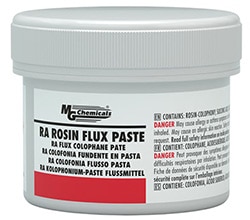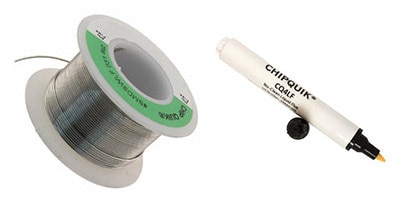How to Solder with Flux
 (Image source: MG Chemicals)
(Image source: MG Chemicals)
Flux is a substance created for cleaning mildly dirty or oxidized surfaces while soldering. Some solder has a flux core. The flux has a lower melting point than the solder itself to allow it to flow over the surface and clean it to remove contaminants from the surface. Now this may be all the flux needed, but sometimes solder doesn’t have a flux core, and oftentimes more flux is still required.
If flux is needed, apply a small amount onto the solder pad before soldering. This should be enough to provide a clean surface. Once the solder joint is made, clean the flux off following manufacturer instructions. This will be dependent on what type of flux is used.
Flux comes in many different compositions. There are the self-explanatory no-clean, water soluble, and rosin activated. The no-clean version uses an additive that will burn off during the soldering process to leave little to no residue behind. Water soluble has an additive that is easily cleaned by using just a little bit of water. Rosin activated has an additive that leaves a sticky residue behind that will require a cleaning solvent, such as flux remover or rubbing alcohol, to clean. It is important to clean the residue off to prevent corrosion over time.
When soldering, if the solder isn’t flowing as it should or making good, clean joints, give flux a try. Sometimes this is all that’s needed to make the process a lot faster and easier.

Have questions or comments? Continue the conversation on TechForum, DigiKey's online community and technical resource.
Visit TechForum












